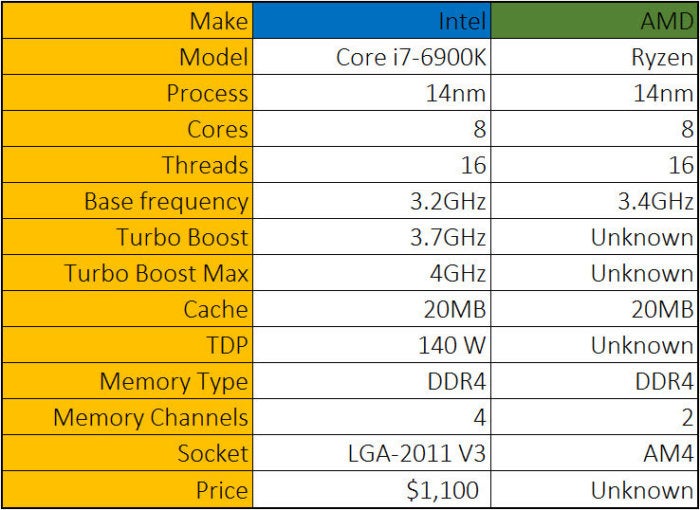The AMD Ryzen is AMD’s newest processor in the making, scheduled for a Q1 release in 2017.
The goal with their newest chip was to match the performance of Intel’s current flagship i7, the Core i7-6900K, and develop a chip that has 40% more instructions per clock than their own previous CPU. Here’s the line up to compare.
As you can see, the turbo boost and max are currently unknown as of now, as well as the price. The TDP however is 95 watts. Even the base frequency in this picture isn’t set in stone, so it may change before the official release.
AMD debuted their new 8-core chip using Blender’s open source application, which showed that it matched and actually slightly surpassed the performance of it’s Intel counterpart. The builds of the computers housed. However, this is only one benchmark test, and an open source benchmark that would allow for recompilation for greater performance on the AMD chip. To quell doubts, AMD later showed more advanced test such as running Hardbrake encode to transcode video and the ZBrushCore benchmark that supported AMD’s original claim. Surprisingly during these benchmark tests, the boost mode on the Ryzen processor was turned off but it still performed faster than the Intel i7.
Lets talk about overclocking the processor. The Ryzen supports overclocking in increments of 25 mhz, which is smaller than the traditional 100 mhz increment on most processors. This means that the processor can be tuned to much more specific clock speeds. In addition to more smaller increments, the new Ryzen processor comes with Extended Frequency Range (XFR), which allows the processor to sense how efficiently it’s being cooled and further overclock itself. This allows for the processor to surpass regular boost clock speed maxes. Another interesting piece of software that runs on the new processor is it uses Neural Net Prediction which helps the processor predict future pathways an application will utilize based off of learning from past application usage.
All in all, AMD’s Ryzen processor may very much hold the future of AMD in how it does on the market. The engineering team at AMD has finally come up with a truly competitive processor to help gain back the market they’ve been losing to Intel over the last decade. AMD has surpassed even their own expectations in terms of manufacturing but it’s up to the consumers after release to truly determine how well the chip will hold up against Intel. It’s also important to note that the Intel card being tested here is an Intel Broadwell Gen 5, a “tick” in Intel’s CPU fabrication. This chip is a generation behind the current Kaby Lake and will soon be two generations behind with the release of the Sky Lake “tock” chips. Although the current price is unknown, I will definitely be considering switching to AMD because of this new card.